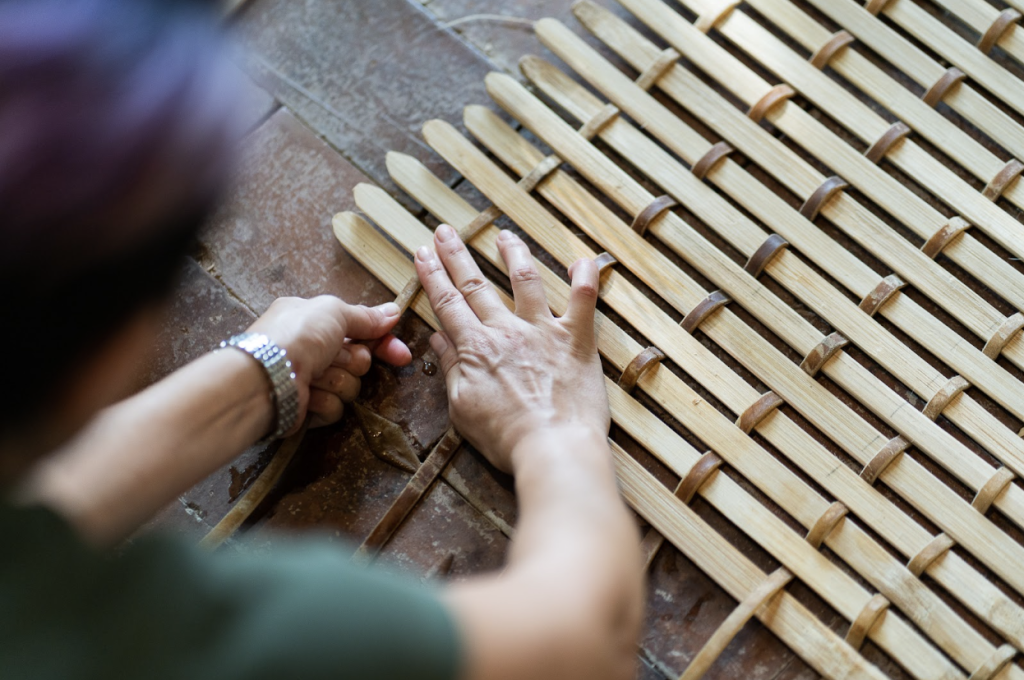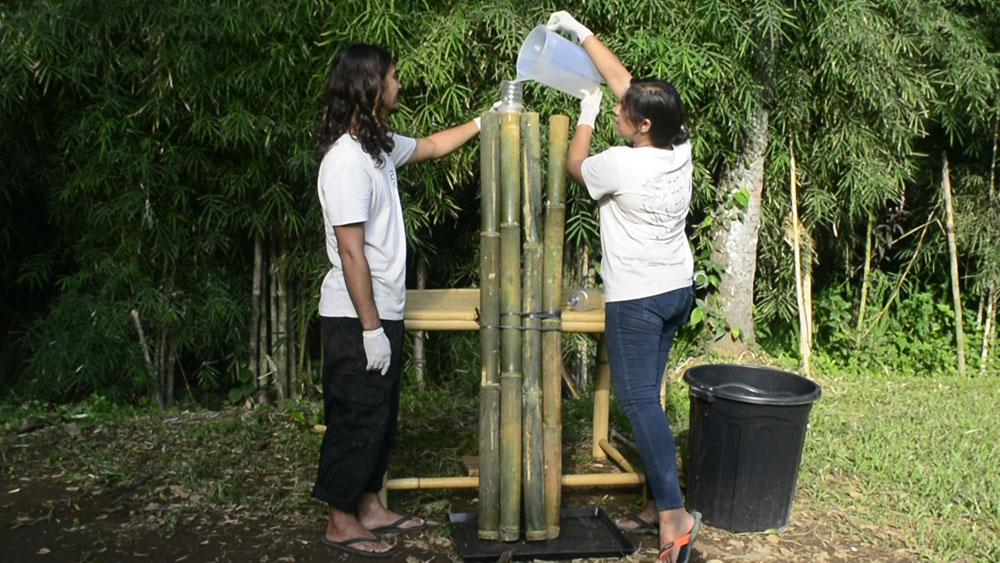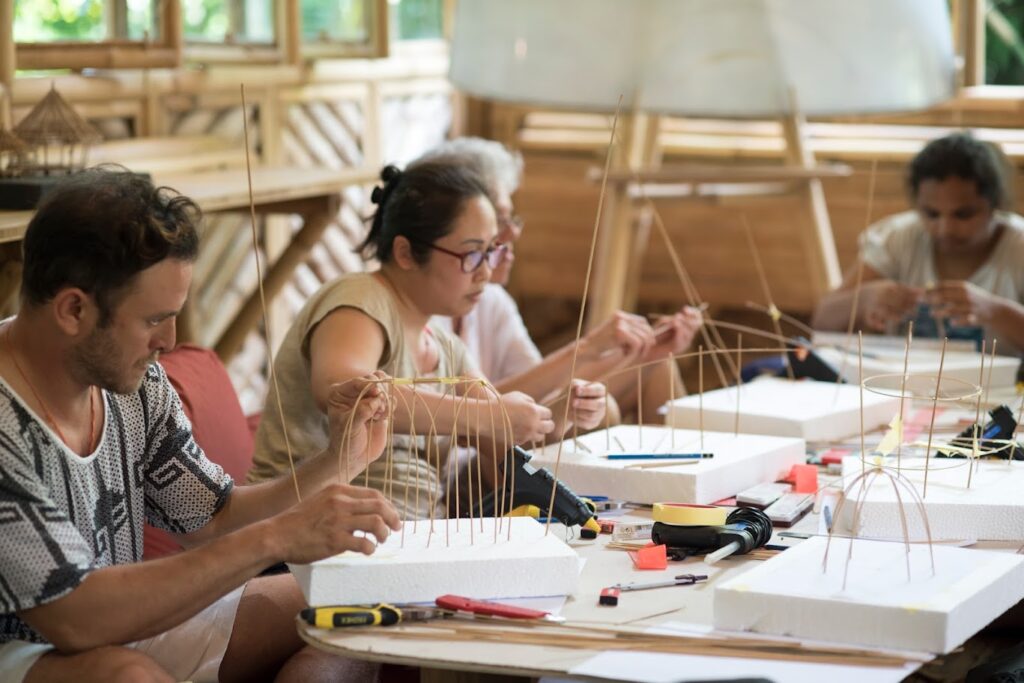Building A Beautiful Bamboo Hammock Chair
By Priscilla Black | October 11, 2022 | Student Work -

Follow the journey of crafting a bamboo hammock chair from scratch in just 4 days during the Bamboo U Build and Design Course.
During the 11 Day Bamboo Build and Design Course in Bali we dedicate the second part of the course for students to either immerse in a full-scale bamboo structure or to work with master carpenters and a resident designer to fulfill a prototype for a small-scale bamboo object or furniture piece. In so doing, it is our aim that working hands-on with bamboo will give students a deeper understanding of bamboo as a building material.
Last July 2022 Priscilla joined us from the United States to immerse in bamboo education, to receive knowledge and hands-on experience in building sustainably whilst also getting to see the beautiful bamboo buildings in Bali in person. In the second part of the 11-day course she worked on a design for a bamboo hammock called: Ecolibrium Hammock Chair.

Design Idea, Concept and Inspiration
The idea was to create a comfortable hammock chair that would be easy to transport from Bali to the U.S. I was inspired by the idea of creating balance and testing out the strength and structure of bamboo in combination with a tensile member such as rawhide.
The bamboo splits provide enough rigidity in one direction to give sufficient support along the body of the chair, while the rawhide strips running perpendicular would allow ergonomic flexibility that would mold to the user’s body and also allow for the chair to be rolled in one direction for easy storage and transportation.

Crafting The Bamboo Hammock Chair
The species Phyllostachys aurea known locally in Indonesia as Bambu pancing was used for the top and bottom of the chair. These pieces serve as the rigid structure that defines the “headrest” at the top and seat support at the bottom. Blonde Bambu tali, also known as Gigantochloa apus was used in the form of thin splits for the body of the chair on the horizontal axis and rawhide on the vertical axis. Bamboo bona was used for the armrests and a natural fiber rope was used to hang the chair from the ceiling using butterfly knots and figure 8 knots.
Although the blonde Bambu tali splits and the rawhide strips can be quite bendable as individual pieces, they become a strong flexible surface when tightly.

Challenges and Learnings
The most challenging part of the project was estimating the rawhide length before cutting strips for weaving. Considering the hammock would not end up in a straight line when being used and that the curvature would vary depending on the user, estimating the length of material to be used became a matter of gut feeling and estimation. The biggest reward was seeing it complete and realizing that it takes much heavier weights than I originally thought. If I was to remake it I would make the seat longer, double the rawhide and consider making the armrests with a thinner species of bamboo to balance out the proportions of the rest of the chair.
Another challenge was to maintain the shape of the hammock without it collapsing into itself. The Bambu bona poles were added to the sides at that point to serve as both armrests and to maintain the chair open and inviting while nobody is sitting on it.

The time I spent submerged in the Bamboo U teachings, the land, and the passion of the people that this organization brings together has changed my life and has brought a new level of inspiration to my career. This experience has motivated me to take action on the previously dormant desire to do my part in the environmental crisis that our world faces. As an architect in the US, I’m getting my license and all legal certifications necessary to get a bamboo project approved in my local jurisdiction. Starting with an addition to my own home I would like to set a precedent for a bamboo structure that has been approved by a local building department for construction in the state of Florida. In the meantime, I will continue to work at a smaller scale with furniture to bring bamboo into the local markets and keep educating everyone around me about the beauty and sustainable properties of this wonderful material.

Priscilla is from Ecuador but now lives in the United States where she studied architecture at Florida Atlantic University and has been practicing professionally since 2007. She has worked on different project types and sizes; from small-scale bus stops, to larger aviation, residential, commercial, hospitality, and mixed-use highrise buildings. Her diverse exposure and her passion for sustainability has propelled her to pursue a more environmentally conscious practice as she sees the need for architects, designers, and engineers to focus more on sustainable practices.Her commitment to environmental awareness led her to travel around the world and find new ways of using sustainable materials and resources such as bamboo, which has opened a doorway for Priscilla to develop new environmentally friendly creations including furniture and smaller-scale products while still applying her knowledge on structure and design acquired through her training and practice in architecture.
OCTOBER 10-21, 2025
The 11 Day Bamboo Build & Design Course in Bali
In 11 days, we'll show you how to build bamboo structures we’ll share all that it takes to build with nature.
Start Anytime
The Bamboo Harvesting Course
The Bamboo Harvesting Course is an online step-by-step training to harvest and care for your bamboo clumps to ensure their longevity and productivity. This maximizes the potential of this beautiful grass as a rapidly renewable resource.Whether you are an architect, builder, or sustainability enthusiast, this mini course will enable you to utilize this rapidly regenerative resource as a durable construction material.It will help remove any fear or doubt about the durability of bamboo and help you build reputable bamboo structures that stand the test of time!
















